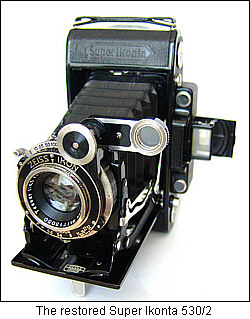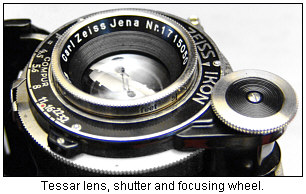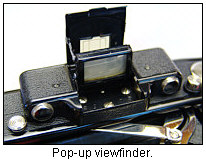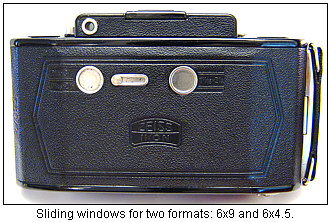
Zeiss Ikon Super Ikonta 530/2: Living Large
 This
was the top of the line for 6x9 cameras. The best of the best for that period.
That period in time was the mid-1930s. It was a period of great change in
the photographic industry. The roll film had arrived, pushing aside plate
film, which continued to enjoy some popularity. This
was the top of the line for 6x9 cameras. The best of the best for that period.
That period in time was the mid-1930s. It was a period of great change in
the photographic industry. The roll film had arrived, pushing aside plate
film, which continued to enjoy some popularity.
The Leica -- and its "miniature" 35mm format -- was gaining acceptance
in the marketplace, and Kodak had responded with its daylight-loading 35mm
film cassette and the Retina from its Nagel Works plant in Stuttgart. Nearby,
Zeiss Ikon brought to the market its boxy Contax and then followed several
years later with the much-improved Contax II.
In 1934, Zeiss Ikon released three Super Ikonta cameras for the 120 format.
There was the Super Ikonta A, which gave 16 6cm x 4.5cm shots per roll.
That was accompanied by the Super Ikonta B and its 6x6 format. The camera
featured an auto framing mechanism that banished the need to precisely wind
the film so that the frame number appeared in the little red window. This
was accomplished with the loss of one frame, so the Super Ikonta B gave
11 shots, rather than 12.
Then there was the Super Ikonta C -- a large camera that tipped the scales
at 28 ounces. This camera delivered just eight shots on 120. There's a
lot of negative in 6x9. No need to use a loupe to try to figure out
what you've photographed. It's right there in front of you, plain as the
nose on your face. And if that wasn't big enough, Zeiss Ikon offered the
Super Ikonta 530/15 model, which I believe used 116 film.
Like its other Super Ikonta siblings, the C uses rotating wedge prisms
for its rangefinder system. The prisms for the A and C cameras are mounted
on an arm that folds neatly against the shutter housing when it's time to
put the camera away. The C becomes reasonably compact for such a large piece
of precision machinery. Extended, the rotating wedge prism system is very
effective and very accurate.
The prewar Super Ikontas featured the four-element Tessar or the three-element
Triotar with the Tessar being the premium optic. The prewar A came with
an f/3.5 7.5cm Tessar, and the B model always carried the f/2.8 8.0cm Tessar.
My particular camera has the f/4.5 10.5cm Tessar, uncoated, of course. Other
Super Ikontas can be found with the f/3.8 Tessar of the same focal length.
From what I can tell, this probably is the second 530/2 model. The first used a small plunger near the lens to trip the shutter. The
earliest model also lacked a sliding cover for the red windows that display the frame number. The successor 531/2 -- introduced in 1936 --
featured a film advance and shutter release on the top of the camera, as well as double-exposure prevention. One Internet source has
determined that this camera is among the last of the 530/2 models and probably was made in early 1936. The lens was part of a batch of Tessars
produced in July 1935.
Celebrating 'C' Day
 The
camera arrived on a Friday afternoon, just before work, via the U.S. Postal
Service. The camera emerged intact from the box. There was a 620 film spool
inside PLUS a little bonus: the 6x4.5 mask that allows the camera to shoot
16 photographs on 120. The
camera arrived on a Friday afternoon, just before work, via the U.S. Postal
Service. The camera emerged intact from the box. There was a 620 film spool
inside PLUS a little bonus: the 6x4.5 mask that allows the camera to shoot
16 photographs on 120.
A quick inspection showed an extremely dusty camera that begged for restoration.
The bellows were still tight. The rangefinder system, as expected, was dirty,
and the finder was cloudy.
At first, I was certain that this camera used a Van Albada finder, but
my book says the Van Albada finder wasn't introduced until the successor
531/2 model. The Van Albada viewfinder uses a semi-reflective coating to
display the frame lines that are painted on a tiny piece of plastic. Once
it's gone cloudy, there's not much you can do other than to replace it or
simply live with it.
The lens door opened smoothly and locked into position without the need
to apply pressure to the rails or lens. The release for the door also released
the viewfinder, which correctly snapped into its upright position. The paint
was in decent shape with just a few chipped areas.
The shutter, however, appeared to fire at the same speed, regardless
of setting and the film-advance key was very rough to the touch and was
heavily oxidized. The Moroccan leather was in very good shape -- no tearing
or lifting and not worn down to the metal. Just a bit dirty.
The shutter tensioning lever showed some bubbling of the chrome, and
the shutter speed ring had some minor marks, as well. But overall, for a
camera that was more than 70 years old, I was very pleased. As I like to tell
people, I hope I look as good when I'm 70 and have been sitting in a closet
for 20 years (although I hope no
one puts me in a closet for the next two decades).
Bringing it back to life
 My
usual restoration work took about six hours spread over one weekend and
included a teardown of the shutter, disassembly and cleaning of the rangefinder
system (including the rotating wedge prisms), cleaning the lens groups and
treating the leather. The film chamber was very dusty, but happily there
were no signs of impact damage, rust or corrosion. My
usual restoration work took about six hours spread over one weekend and
included a teardown of the shutter, disassembly and cleaning of the rangefinder
system (including the rotating wedge prisms), cleaning the lens groups and
treating the leather. The film chamber was very dusty, but happily there
were no signs of impact damage, rust or corrosion.
I used some FlitzTM
to restore the luster to the chrome. As I had hoped, the oxidation on the
film advance key buffed away without too much effort. I did the same on
the other chrome parts.
One of the aperture blades jumped off track but I was able to work it
back into its pin placeholder. Good thing, because disassembling and reassembling
aperture blades isn't for the faint of heart. I've done it before, and each
time, it usually takes about 30 minutes to reseat all of the aperture blades.
I used some glossy black automotive touch-up paint to fill in the chipped
areas on the black enamel.
I recalibrated the rangefinder, recollimated the lens and reassembled.
This is one fine camera, and it was well worth the effort I put into it.
Beauty is subjective, but I find this to be a visually stunning camera.
From the workbench out into the real world
 What
good is a camera if it's not used? So now it was time to give it a test
run. For my first roll, I decided to go with Ilford Pan F -- a classic black
and white film that has fine grain, wonderful tonality and is very easy
to handle. What
good is a camera if it's not used? So now it was time to give it a test
run. For my first roll, I decided to go with Ilford Pan F -- a classic black
and white film that has fine grain, wonderful tonality and is very easy
to handle.
After tracking down a spare 120 spool, I loaded the film, which was uneventful.
The camera is a handful. The first thing with a camera this size is to
not let the lens bed flop open. It's not good for the camera, and it's possible
that it will flop out of your hands and onto the ground. And that's really
not good for the camera.
The next trick is actually holding the camera securely. The best method
is the "hamburger" grip. Form a big "C" with your left hand (a "C" like
the Ikonta C, get it?) as if you were holding a hamburger that you see in
the commercials and not the one that actually arrives on your plate. Now,
grip the camera with that hand. Your fingers should curl around the top
of the lens bed, and your thumb should support the bottom of the Super Ikonta.
The index finger rests on the shutter release quite naturally.
The right hand will be used for focusing the camera and to provide additional
support when taking the photo.
 In
use, it's slow going because of the separation of focusing and framing.
But with just eight frames per roll, you're willing to take your time. Slow
down and enjoy the moment. In
use, it's slow going because of the separation of focusing and framing.
But with just eight frames per roll, you're willing to take your time. Slow
down and enjoy the moment.
The shutter release is surprisingly smooth, and adds little or no extra
movement to the camera. The clouded viewfinder is another story. I might
remove the coating altogether, because it's a struggle to frame my photo.
The camera is well balanced, even with a lens that's sitting 4 1/2 inches
from the film plane. Vertical photos are a snap, and it doesn't take too
long to shoot off eight photos. OK, in reality, it took me three days, because
it was sandwiched between cutting the grass, installing three air conditioners
and going to work early. But if it hadn't been for that, I would have knocked
out the eight frames with ease.
Man, I love this camera. And you will too, if you can find one. No, you
can't have mine.
See the next page for photos »
|